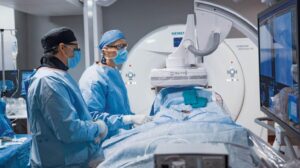Compared to migraines and other head pain, occipital neuralgia is relatively uncommon. Occipital neuralgia is most known as a headache syndrome that involves the occipital nerves. The condition is sometimes confused with a migraine or headache, but occipital neuralgia only occurs when the occipital nerves are inflamed or injured. Compared to migraines and other head pain, occipital neuralgia is extremely uncommon. Similar to many conditions like psychiatric disorders, this occipital neuralgia is diagnosed primarily from symptoms and scans.
Anatomy of the Occipital Nerves


Why do this procedure? (Indications)
Pain felt around the occipital (back of the head) region is often transmitted to the brain via these Occipital Nerves. Patients suffering from this type of pain are good candidates for injection to the Occipital Nerve, which is expected to disrupt the pain signals reaching the brain. If the injection contains a long-lasting steroid such as Betamethasone (Celestone), then patients may get long-term relief.
If the patient does have relief from their pain after the injection has been performed but their pain returns at some stage then there are 2 options
Repeat the injection – especially if the patient obtained long term relief; or
Use the injection as the indication for Pulsed Radio-frequency to the Occipital Nerve to possibly provide longer-lasting relief (this is a longer-term treatment option)
Why inject the Occipital Nerves?
It is a sterile procedure, which passes a needle through the skin along the bottom of the skull between the mid-line and the ear (Mastoid Process) Local anesthetic and steroid is usually injected under the skin in the correct areas the Greater and Lesser and Third Occipital Nerve in order to inhibit the transmission of pain signals.. If the procedure is a success, there is no way of knowing how long it will last.


How effective will it be?
It is not possible to predict or guarantee the effectiveness of any treatment. However, the fact that this procedure has been recommended means that it may be of use.
There are several possible outcomes:
It may treat the pain so that the pain does not return
It may treat the pain for a short period of time (weeks to months) and then the pain returns either less or the same as before. In this situation, a repeat procedure could be indicated.
How is the treatment performed?
The procedure will be done as a clinic or rarely as a day patient. The injections may be performed in day surgery using a mobile X-ray machine for guidance, or “blind” in surgery using anatomical landmarks. In the theater, you will be placed onto the procedure table face down, lying on some pillows for your comfort. We need to get you into the correct position before we start the procedure.
If you are on blood thinners (warfarin), please let the doctor know well in advance as special arrangements will have to be made. Please also bring a list of your medications and any allergies. You will need someone to drive you home after the procedure.
Procedure technique
Before we start the procedure in the operating theatre, a small intravenous cannula will go into a vein in your hand. The process is routine and allows us to administer any medication needed, such since medication for sedation or fluids if necessary. Your lower back will be uncovered and cleaned with an antiseptic solution to prevent infection. Local anaesthetic is then applied to numb the skin before starting. An additional anaesthetic will then be administered to numb the space between the skull and the skin in the region of the Occipital Nerves. A needle is injected into the correct area. If you are awake, sometimes a feeling of pressure develops in the skull and neck region – this is usually only mild and temporary.

COMPLICATIONS
This procedure is usually safe and uneventful. However, as with any medical procedure, there is always a small degree of risk.
Common Complications
Continuing pain / no benefit
Minor bleeding in the area treated
Bruising or numbness in the area treated
Temporary weakness or insensitivity from the local anaesthetic
Brief increased pain that may fluctuate in intensity
More Serious Side Effects
- Very rare risk of surgery due to injuries from the procedure
Please discuss any other questions you may have with your doctor regarding this procedure. If you agree to have the procedure done, you will need to sign a consent form.




















